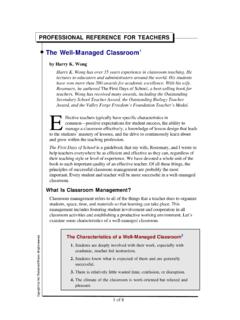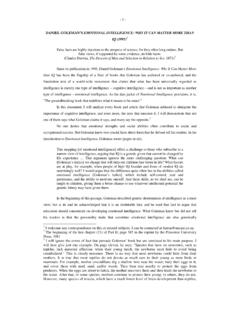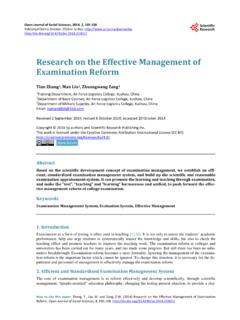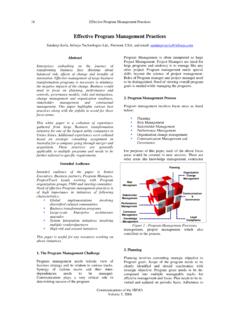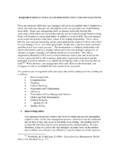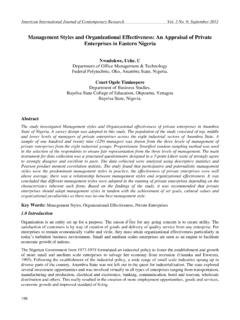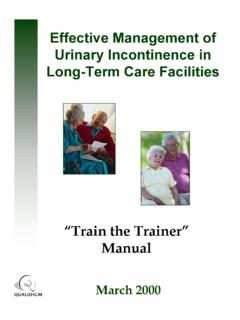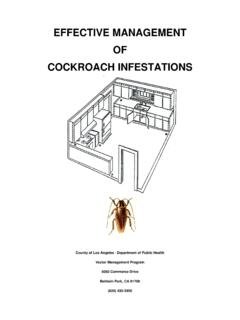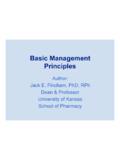Transcription of Effective Classroom Management - Waterford Teachers' …
1 Effective Classroom Management Effective Classroom Management is: 1. Planned not improvisational 2. Preventative rather than simply reactive 3. Controlled and organized rather than chaotic 4. An opportunity for all students and teachers to experience success Tips for Arranging the Classroom 1. Have extra supplies available at a location in the Classroom where students who have forgotten supplies will be able to go without disrupting other students ( a cup of pencils at the center of each table or the back of the Classroom ). 2. Set a good example to your students by providing a neat and organized Classroom . 3. Make your Classroom look attractive. Use plants, bulletin boards, banners, warm colors, or anything to help make your Classroom look aesthetically pleasing. 4. Structure your Classroom as to avoid chaos and promote learning. For instance, do not place a talkative student next to the pencil sharpener because this creates many opportunities for disruptive behavior.
2 5. The teacher should be able to observe all students at all times and be able to see the door from his/her desk. 6. Students should be able to see the teacher/presentation area without having to move or turn around. 7. Arrange the room as to allow easy movement. 8. Main idea: Make your Classroom fun, attractive, motivating, & functional. Tips for Building Positive Student/Teacher Relationships 1. Follow the Golden Rule Treat each student with respect and kindness. 2.. Identify a few students each class period and find ways to individually praise them so that by the end of the week every student in your class has been praised. 3. Be available before and after school in case a student needs help or simply needs to talk to you. 4. Praise students for good work. 5. Praise students for effort. 6. Establish appropriate levels of dominance and cooperation. 7. Create one-to-one interactions with students. 8. Display students successful work in the Classroom .
3 9. Disclose appropriate personal information that your students might find helpful ( share a personal story that helps you describe a particular point of the lesson). Time Saving Strategies Center for the Advancement of Mental Health Practices in Schools 1 1. Establish time-saving, efficient routines for collecting papers and distributing materials and supplies ( bins for each subject or class, mailboxes for each student or class). 2. ORGANIZE! ORGANIZE! ORGANIZE! 3. Establish daily routines. 4. Make a To Do List at the end of each day so that when you arrive the next morning you know exactly what needs to be done. Prioritize it and list the things that must be done first. 5. Create Classroom jobs. This will help save you time and teach them responsibility. 6. Create a system for monitoring unfinished assignments. ( Keep a clipboard with a list of student names with several boxes for each class next to each name. When you have finished grading the assignments, check off the boxes next to the students who have handed in the assignment.)
4 7. Teach your students how to be organized. Encourage them to have separate folders for each class and a home folder for assignments/notes. 8. Create your own filing system. Assign each class a color and keep important lesson materials in each folder. Instructional Tips 1. Give directions one step at a time and avoid long and detailed directions. 2. Use visual aids to help present and review concepts and directions. 3. Provide a variety of learning experiences, including peer teaching, cooperative learning, small group instruction, and lecture. 4. Provide homework assignments and activities that are meaningful, relevant, and instructional. 5. Teach students good study habits and provide a variety of different study suggestions. 6. Have your class summarize the lesson or activity at the end of each class. 7. Provide students with feedback (about what they did right and wrong). 8. Help your students set realistic goals. Tips for Creating a Positive Classroom Environment 1.
5 Use humor. 2. Greet students at the doorway and in the halls. 3. Show enthusiasm and be animated. 4. Provide opportunities for every student to succeed. 5. Model good listening skills by paying attention when student speak. 6. Create anticipation for lessons or tasks. 7. If a particular student is struggling, provide the student with a Classroom buddy who is mature and responsible. 8. Create Classroom rituals and traditions which build a sense of community. 9. Encourage parental and community involvement. Tips for Preventing Misbehavior 1. Establish realistic and age appropriate rules and procedures. Center for the Advancement of Mental Health Practices in Schools 2 2. Have discussions with your students about the rationale and purpose of each rule. When appropriate, incorporate student opinions and thoughts into your Classroom rules and procedures. 3. Walk throughout the Classroom during lectures and seat work to provide assistance and monitor behavior.
6 4. Keep class work and assignments separate from behavior issues. 5. Carefully plan each class time and have extra plans in case you finish early. 6. Have extra activities available for students to do when they are bored or finished with all their work. 7. Establish routines for transitions (leaving the room, using the bathroom, etc.) and prepare students for transitions by warning them ahead of time. 8. Reinforce and praise appropriate behavior. 9. When deciding whether or not to intervene with a behavior, determine if the problem is solely teacher-owned. Does the behavior simply annoy you or is it harmful to other students? 10. Establish a program that teaches self-discipline and responsibility to students. When appropriate, give students extra duties that will help save you time and teach them responsibility. Tips for handling student discipline situations 1. REMAIN CALM AND COMPOSED! 2. When correcting misbehavior, communicate in the most private, respectful, and positive manner.
7 3. Make all discipline decisions after the heat of the moment. 4. Use appropriate humor to de-escalate conflict situations. 5. When you feel as if you or your student is too emotional to handle a particular situation, suggest postponing the discussion until both are prepared to talk it out. 6. Instead of blaming, use I-messages to explain why the behavior was disruptive. Instead of saying You re disruptive try saying I lose my concentration when you are talking in class. This helps to avoid an angry retaliation. 7. Use positive self-talk to reduce stress and help to remain control. Mentally say things such as remain calm, I m doing a good job at handling this situation. 8. Attempt to de-escalate situation by providing distractions. These distractions give people the opportunity to cool off. 9. Exaggerate issues to help students put the situation in perspective. 10. Use stress Management techniques such as deep breathing or repeatedly tensing and relaxing your muscles.
8 11. Address only student behavior rather than personal traits. Additional WebsitesAdjustments in Classroom Management Center for the Advancement of Mental Health Practices in Schools 3 Classroom Management Management : Effective ways to have an orderly Classroom Management & managing student conduct Management tips Management sites world: The educator's best friend really big list of Classroom Management strategies teacher's guide Resources Authentic Classroom Management : Creating a Community of Learners Author: Barbara Larrivee Best Classroom Management Practices for Reaching All Learners: What Award-Winning Classroom Teachers Do Author: Randi Stone Classroom Management that Works: Research Based Strategies for Every Teacher Author: Robert J. Marzano, Jana S. Marzano, Debra J. Pickering Principles of Classroom Management : A Professional Decision-Making Model Author: James Levin & James Nolan What Works in Schools: Translating Research into Action Author: Robert J.
9 Marzano Center for the Advancement of Mental Health Practices in Schools 4
